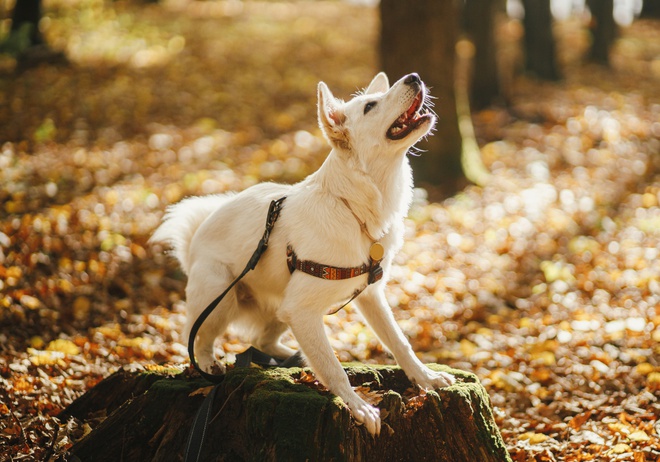How to train a dog to stop barking?
Although barking is a natural way of communication for dogs, excessive barking may become tiring and frustrating for the dog’s owner as well as the neighbours. In this article, we provide useful information on how to train your dog to stop barking.

Reading time : 7 min
Before you start training your dog to stop barking, it’s important to realise that barking, next to whining, growling, and howling, is a natural and common form of canine communication and a way of vocalising dogs’ needs. This means that your goal should not be to fully eliminate, but to decrease the excessive barking of your pet.
You also need to keep in mind that the longer your dog has been practicing the barking behaviour, the longer and harder it might be for you to train them not to bark and to develop different means of communication. Training your dog to stop barking can be a strenuous and exhausting process, so your patience, consistency, and perseverance are key factors to success.
Apart from that, you need to take into consideration the fact that some breeds, like Beagles and Terriers, are more prone to barking than others, which makes the training harder, if not impossible.
TOPICS
Why does my dog bark?

There are plenty of reasons why your dog barks. To be able to find the best solution and method to stop your dog from barking, it is first important to diagnose the reasons behind the problem.
Why is it important to recognise the type of barking?
Depending on the type of barking and the motivation that provokes it, a different type of training might need to be implemented. You should first understand why your dog is barking, as it can indicate which method to use.
Among the most common types of barking are territorial, alarm, boredom, greeting, attention-seeking and separation anxiety barking. Identifying the reason and thus the type of barking will allow you to implement one of the training techniques. To find out the source of the problem, observe your dog and try answering the following questions:
- When and where does the barking happen?
- Who or what is the target?
- What stimuli trigger the barking?
Having determined the type of barking, you will be able to introduce the most appropriate technique of dog training.
It is also crucial to keep in mind that excessive barking might be caused by some medical problems, from the trivial to more serious ones. Before starting the training, make sure to have your pet checked by a vet to exclude medical problems.
Different types of barking
If your dog barks at other people, animals or at vehicles, either when at home or outside, it might be a sign of territorial or alarm barking. These types of barking can also be triggered by certain sounds, and they often characterise with the dog looking alert or even aggressive.
It’s important to distinguish between territorial barking and greeting barking, which might be provoked by the same stimuli. Greeting barking also occurs when the pet sees other dogs and people, but their body language is much different: they look relaxed, and the bark can be accompanied by tail wagging and jumping.
Boredom barking appears when your dog is left alone for long periods, and they tend to signalise that they are bored and unhappy. Similarly, attention-seeking barking indicates that your dog wants something from you, be it going outside, playing, or getting food.
Lastly, separation-anxiety barking may indicate more serious problems. Similarly to boredom barking, it also occurs when the dog is left alone for a longer period of time, and becomes anxious. This type of barking signalises behavioural problems, and among other symptoms you may observe pacing, destructiveness, or even depression. This type of barking should often be treated with the help of animal behaviourist or professional dog trainer.
6 ways to stop your dog from barking

Ignore the barking
One of the reasons your dog is barking might be trying to get your attention. If that’s the case, first step in teaching them not to bark is by ignoring this behaviour for as long as it takes them to stop barking. Although it may be difficult, make sure not to touch them, talk to them or look at them, as that’s exactly the reaction your dog is expecting. Instead, reward them with your attention and/or a snack once they stop barking, even if it’s just to take a breath. Make sure that your timing is on point – giving your dog a treat when they bark will confuse them. Remember to be consistent and don’t give up. With time your dog will learn that remaining quiet, and not barking, can give them the reward they expect.
Remove the stimuli
If your dog tends to bark at other people, animals, or vehicles, the fastest and the most effective solution is to remove the motivation of the barking from their sight. Closing the window curtains or installing removable film on the windows are some of the solutions that should block the dog’s view of other people and animals, thus not giving them a reason to bark.
Desensitise your dog to stimuli
If your dog barks at other people or animals during walks, it is obviously impossible for you to completely remove the motivation of barking from their sight. In this case, you might want to try desensitising your dog to stimuli that causes the unwanted reaction. Start with showing your dog the stimulus from a big distance, so that they don’t bark instantly when they see it. Feed your dog treats and move the stimulus closer, continuing to feed them treats until the dog starts barking. When the stimulus is out of sight, stop giving the treats. This technique will teach the dog to associate the appearance of the stimulus with good things, namely treats (that should be gradually reduced during training).
Ask the dog for another behaviour
It is common for dogs to start barking when they hear the doorbell, or when someone is coming home. That’s their natural way of greeting the newcomers or signalling their eagerness to play. To reduce this type of barking, you may try teaching your dog another behaviour instead, such as lying on their bed or bringing a toy, as a form of distraction. Make your dog go to a certain spot (e.g., their bed) or bring a toy when the door opens or the bell rings. Reward them with a treat if they do that; if they start barking, don’t give them snacks. Repeat this action until your dog automatically executes these actions without you giving the commands.
Keep your dog tired
Never underestimate the fact that a tired dog is a good and quiet dog. Make sure to incorporate enough exercise to your dog’s daily routine, bearing in mind that different dog breeds have different needs. Your dog might be barking out of boredom or to make you play with them, so providing them with mental stimulation aside from physical one, such as training, food toys and scent games, should solve the problem as well as make your dog healthier and happier.
Reward the absence of barking
Many of the training techniques to stop the dog from barking are based on the system of rewards and positive reinforcement. It is a good practice to reward the good dog behaviour not only during training sessions, but also outside of them. When your dog is quiet on their own, feel free to give them a treat or play with them. This will teach them that they don’t necessarily have to bark to get your attention, and that absence of barking is linked with something good.
10 questions to test your pet training knowledge
Do you know everything there is to know about training dogs and cats? Answer our 10 questions to find out!
Are anti-bark collars safe to use?

Although there are many techniques to train dogs to stop barking, they might not always be fully effective. If the above tips result unsuccessful, you may want to try using anti-bark collars. Before doing so, we recommend you read about them to make an informed and responsible decision.
Different types of anti-bark collars
There are several types of anti-bark collars available on the market, most of which are programmed to emit an unpleasant stimulus when the dog barks. Among the most popular types, there are sound collars that produce a high-pitched or audible sound, electronic collars that deliver an electric shock, and citronella collars that emit a burst of citronella spray near the dog’s face when they bark. Using anti-barking collars is controversial, with various pet organisations advocating against them, due to the harmful effects that they may cause.
Pros and cons of anti-bark collars
Pros of anti-bark collars:
- Anti-bark collars make training a lot simpler
- They don’t require much input from the owner
- They can be successful when all the other methods and tips fail
Cons of ani-bark collars:
- They aren’t effective on all dogs
- Shock collars cause harm to dogs and can make them aggressive
- Dogs quickly become “collar wise,” which means that they learn not to bark when wearing the collar, but continue to do so when they’re not wearing them
- Anti-bark collars are not recommended in the households with more than one dog – one dog’s barking can activate the sensor on another dog’s collar
- Such collars are punishment devices and thus they’re not recommended as a first choice
Tips on training your dog not to bark

Apart from the above-mentioned training methods, there are some tips that will make the training process easier and more enjoyable both for you and your dog. During the training session, don’t yell at your dog and don’t talk to them when they’re barking. The dog may think you’re joining them in their communication, and thus get confused.
House training your dog might be a source of frustration, but it’s important to keep the situation under control and not punish your dog. Keep the training sessions positive and varied to make sure that they are pleasurable for both parties.
Be consistent and perseverant and remember that repetition is the key to success. Make sure that all the family members follow the rules of training. Don’t train your dog to bark in certain situations at the same time teaching them not to bark in others since that can only lead to confusion. Teach your dog “hush” or “quiet” to stop uncontrolled barking, and don’t reward them for barking.
Conclusion
Training the dog to stop barking may be a difficult and long-lasting process, but it is definitely worth the effort if your dog’s excessive barking disturbs your or your neighbours’ life. Diagnosing the reason why your dog barks and choosing the appropriate training method are crucial steps to success.
Remember that your patience and consistency are necessary for the training to bring positive effects. If the methods provided in the guide fail, you might have to consider contacting an animal behaviourist or dog trainer, who will help you prepare a training tailored for the dog’s needs.
Continue reading our guide
This article is a part of a complete guide on the subject. Do not miss the next chapters.
Do you know everything there is to know about training pets?
Answer our 10 questions to test your pet training knowledge.
